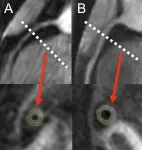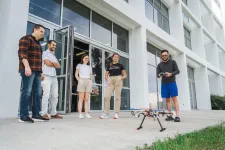(Press-News.org) A nerve-stimulation treatment for obstructive sleep apnea that originally was approved only for people with body mass indexes (BMIs) in the healthy range recently was extended to patients with BMIs up to 40, a weight range generally described as severely obese. A healthy BMI ranges from 18.5 to 24.9.
The expanded eligibility criteria for the treatment provide more sleep apnea patients with access to the increasingly popular therapy, known as hypoglossal nerve stimulation. However, new research from Washington University School of Medicine in St. Louis indicates that the likelihood of successful nerve-stimulation treatment drops significantly as a patient’s weight rises above a healthy range.
The study, which appears April 4 in JAMA Otolaryngology-Head & Neck Surgery, is based on a retrospective analysis of treatment success in 76 sleep apnea patients with BMIs of less than 35.
“Our study shows that the more overweight you are, the less likely it is that nerve-stimulation treatment will be effective in treating your sleep apnea,” said senior author Eric C. Landsness, MD, PhD, an assistant professor of neurology.
“I’m not saying that we shouldn’t put this device in patients with a BMI of 38 or 40. But my job as a physician is to help overweight patients make an informed decision, to better understand their odds of success and realize that the chances of it working for them may be a lot less.”
Obstructive sleep apnea is caused by relaxation of muscles in the mouth and throat when a person is asleep. Muscle slumping can cause a partial or complete blockage of airflow and oxygen supply, especially in people with large tongues, thick necks and narrow airways. Blockages may cause people with sleep apnea to stop breathing for seconds (sometimes more than a minute), until they startle themselves awake and gasp for breath, a cycle that often repeats through the night. Untreated sleep apnea can cause serious health problems, including excessive daytime sleepiness, headaches, strokes, irregular heart rhythms and other cardiovascular issues.
Sleep apnea most often is treated with a bedside continuous positive airway pressure (CPAP) machine, which maintains open airways via a breathing hose and tightly fitting face mask. CPAP machines are effective, but they can be loud and uncomfortable and are largely unpopular. About half of those who try the approach fail to stick with it.
To many patients, hypoglossal nerve stimulation looks like an appealing alternative to CPAP machines. The therapy is driven by a small, battery-operated device implanted just above the ribs. A small wire is run internally up the chest and into the jaw, where it connects to the hypoglossal, a nerve that controls tongue muscles responsible for keeping the upper airway open during sleep.
Each time the patient takes a breath, the device delivers electrical impulses to the hypoglossal nerve, causing the tongue to move forward just far enough to avoid the airway blockages that drive sleep apnea.
The first hypoglossal nerve-stimulation device (brand name Inspire) was approved by the U.S. Food and Drug Administration (FDA) in 2014 for use in patients with BMIs less than 25 whose moderate to severe sleep apnea has failed treatment with other, more established therapies. Since then, eligibility requirements have loosened, with the FDA now allowing the device to be used in patients with BMIs as high as 40 and Medicare providing coverage for patients with BMIs up to 35.
Landsness, a sleep researcher who treats patients with sleep apnea, was surprised by the changes in the eligibility criteria. To understand how the device performs in people of varying sizes, he and colleagues performed an independent evaluation using data from 78 people with BMIs up to 35 who received implants of the nerve-stimulation device at the Washington University Sleep Medicine Center from 2019 through 2023.
The primary study finding was that, overall, the device works. Three out of four patients showed significant improvement in apnea symptoms in the year following implantation. Most study participants experienced symptom reductions of at least 50%, with many showing dramatic reductions to near normal or mild levels of sleep apnea.
However, among overweight study participants with BMIs of 32 to 35, the results were less positive, with the likelihood of successful treatment estimated to be 75% lower than those of study participants with lower BMIs.
“Body mass index is clearly an important factor in predicting whether hypoglossal nerve stimulation will work for an individual patient,” Landsness said. “Our study shows an almost linear relationship between BMI and treatment success. For every unit of BMI increase over 32, the odds of successful treatment decrease by about 17%.”
Inspire is the only FDA-approved hypoglossal nerve-stimulation device available in the United States. The company also markets the device in Europe, Japan and other countries. About 50,000 patients worldwide have been implanted with it.
Implantation of a hypoglossal nerve-stimulation device is a relatively simple outpatient surgery. Among the biggest concerns for patients are in terms of money and time. Landsness estimates that the therapy can cost from $50,000 to $100,000 out of pocket without insurance and take a year to be fully optimized.
“We have patients coming to us who really want this treatment, because they view it as a life-changing alternative to CPAP,” Landsness said. “It certainly can work for some people, but we don’t want to recommend it to patients if there’s a chance their BMIs will affect the device’s usefulness.”
END
Nerve stimulation for sleep apnea is less effective for people with higher BMIs
Popular alternative to CPAP machines may not be appropriate for all
2024-04-04
ELSE PRESS RELEASES FROM THIS DATE:
Severity of RSV vs COVID-19 and influenza among hospitalized US adults
2024-04-04
About The Study: Among 7,998 adults hospitalized during the 16 months before the first respiratory syncytial virus (RSV) vaccine recommendations, RSV disease was less common but similar in severity compared with COVID-19 or influenza disease among unvaccinated patients and more severe than COVID-19 or influenza disease among vaccinated patients for the most serious outcomes of invasive mechanical ventilation or death.
Authors: Diya Surie, M.D., of the Centers for Disease Control and Prevention in ...
Functional limitations and exercise intolerance in patients with post-COVID condition
2024-04-04
About The Study: In this randomized crossover clinical trial with 62 participants, non-hospitalized patients with post-COVID condition (PCC) generally tolerated exercise with preserved cardiovascular function but showed lower aerobic capacity and less muscle strength than the control group. They also showed signs of postural orthostatic tachycardia and myopathy. The findings suggest cautious exercise adoption could be recommended to prevent further skeletal muscle deconditioning and health impairment in patients with PCC.
Authors: Andrea Tryfonos, Ph.D., of the Karolinska Institutet in Stockholm, is the corresponding author.
To ...
Post-COVID not necessarily a barrier to exercise
2024-04-04
People suffering from post-COVID have been discouraged from exercising because early observations suggested it could be harmful. In a study published in JAMA Network Open, researchers from Karolinska Institutet show that post-covid does not mean that exercise must be strictly avoided.
People affected by post-COVID often experience symptoms such as extreme fatigue, shortness of breath, high resting heart rate, and muscle weakness. Symptoms are often exacerbated by exertion.
“The World Health Organization (WHO) and other major bodies have said that people with post-covid ...
Attack and defence in the microverse
2024-04-04
Viruses need hosts. Whether it’s measles, the flu or coronavirus, viral pathogens cannot multiply or infect other organisms without the assistance of their hosts’ cellular infrastructure. However, humans are not the only ones affected by viruses: animals, plants and even microorganisms can all serve as hosts. Viruses that use bacteria as host cells are called bacteriophages (or simply “phages” for short) and are thought to be the most abundant biological entities of all. Just as the human immune system springs ...
Early coronary disease, impaired heart function found in asymptomatic people with HIV
2024-04-04
OAK BROOK, Ill. – A new study found increased coronary vessel wall thickness that was significantly associated with impaired diastolic function in asymptomatic, middle-aged individuals living with HIV. The study was published today in Radiology: Cardiothoracic Imaging, a journal of the Radiological Society of North America (RSNA).
According to the World Health Organization, approximately 39 million people were living with HIV at the end of 2022. Since 2010, HIV-related deaths have been reduced by 51%, but HIV continues to be a major global public health issue, claiming 40.4 million lives so far.
As effective therapy drugs increase ...
Study shows “feasibility” of ending specialist follow-up in patients with low-risk CLL
2024-04-04
(WASHINGTON, April 4, 2024) – A study published today in Blood Advances showed that among patients in Denmark who had slow-growing chronic lymphocytic leukemia (CLL) with no symptoms and a low risk for ever needing treatment, those who stopped seeing their doctors for specialized follow-up had fewer hospital visits, fewer infections, and similar survival after three years compared to those who continued to undergo specialized follow-up.
“To the best of our knowledge, ours is the first study ...
New partnership will allow University of South Florida to advance US Army innovation, bolster talent pipeline
2024-04-04
TAMPA, Fla. (April 4, 2024) – The University of South Florida is broadening its collaboration with the U.S. Department of Defense through a formalized agreement with the U.S. Army.
The five-year educational partnership agreement brings together faculty from throughout the university to conduct critical defense research and provide student internships – helping broaden the talent pipeline for future military needs. Adam Rawlett, senior research scientist for the Army Research Laboratory, and Sylvia Thomas, USF vice president for research and innovation, formally signed the agreement on March 26.
“This new partnership with ...
Pregnant women with obesity talk about difficult childhood experiences
2024-04-04
Sandsæter is a midwife and has seen the development first hand. Increasing numbers of pregnant women are overweight. Heidi Sandsæter has studied what overweight and obese pregnant women perceive as the cause of this development.
“Research in other countries has shown that there is a direct correlation between weight and a difficult childhood in some adults. We wanted to find out if this was also the case in wealthy Norway,” says Sandsæter.
She is a PhD candidate at the Department of Public Health and Nursing at the Norwegian University of Science and Technology (NTNU), and has used data ...
Study shows link between partner gender and orgasm expectations for women
2024-04-04
A new study published in Social Psychological and Personality Science investigated the factors influencing orgasm rates for women across sexual orientations. The researchers report that partner gender plays a significant role in how women approach sex. and their likelihood of reaching orgasm.
Understanding the Orgasm Gap
Previous research has established the existence of an "orgasm gap," where cisgender women are less likely to achieve orgasm during partnered sex compared to cisgender men. This new study delves deeper, ...
Microbial signature of colorectal cancer-associated mutations identified in new study
2024-04-04
Highlights:
Colorectal cancer is associated with a disrupted gut microbiome.
About 40% of people with colorectal cancer have a mutation in the KRAS gene.
Researchers in China connect the 2 in a new study.
Their findings identify distinct microbial signatures in patients with and without KRAS mutations.
The work points to a potential noninvasive biomarker for determining a person’s KRAS status after a colorectal cancer diagnosis.
Washington, D.C.—For about 40% of people diagnosed with colorectal cancer (CRC), the tumor carries a mutation in a gene called KRAS. Many of those mutations have been linked to shorter survival and ...
LAST 30 PRESS RELEASES:
First Editorial of 2026: Resisting AI slop
Joint ground- and space-based observations reveal Saturn-mass rogue planet
Inheritable genetic variant offers protection against blood cancer risk and progression
Pigs settled Pacific islands alongside early human voyagers
A Coral reef’s daily pulse reshapes microbes in surrounding waters
EAST Tokamak experiments exceed plasma density limit, offering new approach to fusion ignition
Groundbreaking discovery reveals Africa’s oldest cremation pyre and complex ritual practices
First breathing ‘lung-on-chip’ developed using genetically identical cells
How people moved pigs across the Pacific
Interaction of climate change and human activity and its impact on plant diversity in Qinghai-Tibet plateau
From addressing uncertainty to national strategy: an interpretation of Professor Lim Siong Guan’s views
Clinical trials on AI language model use in digestive healthcare
Scientists improve robotic visual–inertial trajectory localization accuracy using cross-modal interaction and selection techniques
Correlation between cancer cachexia and immune-related adverse events in HCC
Human adipose tissue: a new source for functional organoids
Metro lines double as freight highways during off-peak hours, Beijing study shows
Biomedical functions and applications of nanomaterials in tumor diagnosis and treatment: perspectives from ophthalmic oncology
3D imaging unveils how passivation improves perovskite solar cell performance
Enriching framework Al sites in 8-membered rings of Cu-SSZ-39 zeolite to enhance low-temperature ammonia selective catalytic reduction performance
AI-powered RNA drug development: a new frontier in therapeutics
Decoupling the HOR enhancement on PtRu: Dynamically matching interfacial water to reaction coordinates
Sulfur isn’t poisonous when it synergistically acts with phosphine in olefins hydroformylation
URI researchers uncover molecular mechanisms behind speciation in corals
Chitin based carbon aerogel offers a cleaner way to store thermal energy
Tracing hidden sources of nitrate pollution in rapidly changing rural urban landscapes
Viruses on plastic pollution may quietly accelerate the spread of antibiotic resistance
Three UH Rainbow Babies & Children’s faculty elected to prestigious American Pediatric Society
Tunnel resilience models unveiled to aid post-earthquake recovery
Satellite communication systems: the future of 5G/6G connectivity
Space computing power networks: a new frontier for satellite technologies
[Press-News.org] Nerve stimulation for sleep apnea is less effective for people with higher BMIsPopular alternative to CPAP machines may not be appropriate for all



